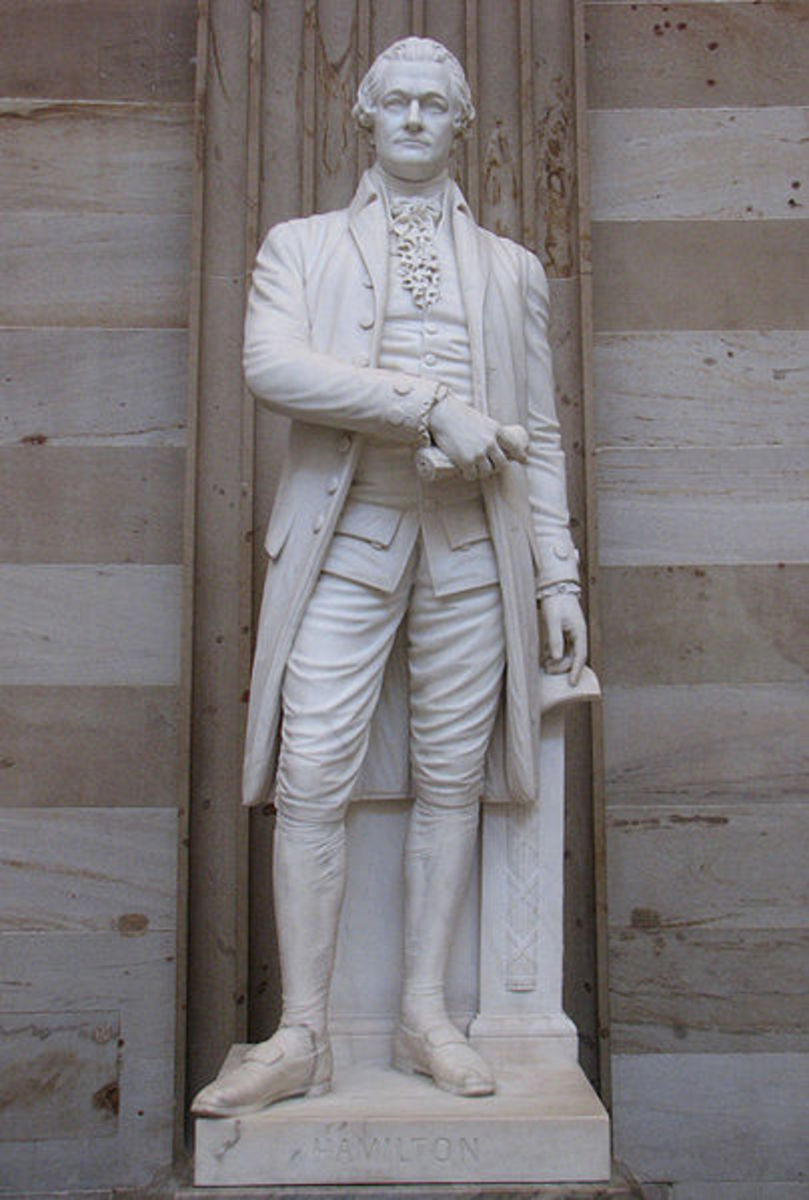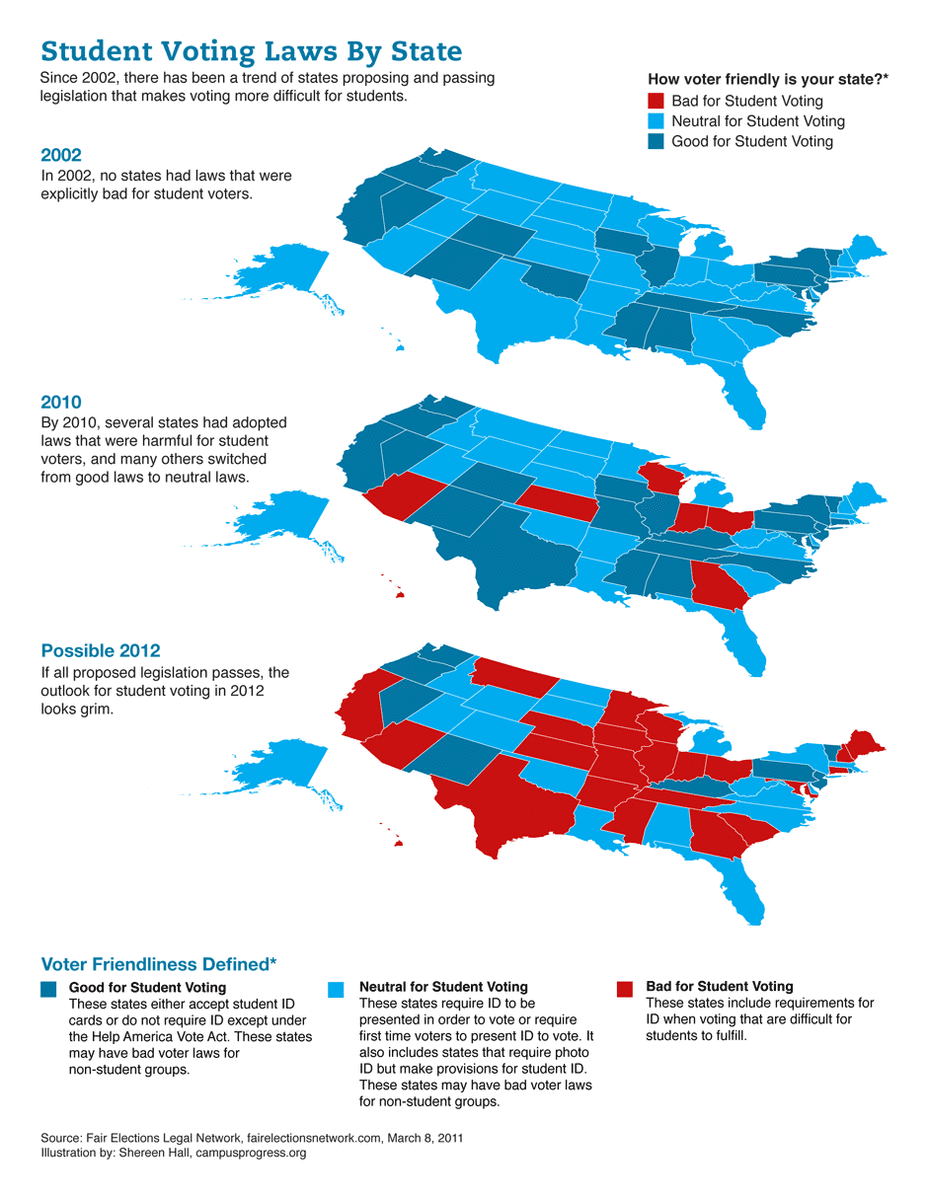Tax Protests and Tea Parties - An American Tradition
It Started With the Boston Tea Party
Tea and taxes became entwined in American culture as a part of our violent birth as a nation when the original thirteen colonies rose in armed rebellion against England's King George III and his tax policies.
Americans were angry with the King and Parliament not only for taxing us without allowing any American representation in Parliament bu also for the army of bureaucrats being sent to administer the taxes and meddle in the internal affairs of the colonies.
The colonists knew that the British government had spent large sums of money helping to defend them in the recent French and Indian War and were willing to help pay for this. They simply did not want the hordes of meddling bureaucrats being sent from London nor the idea that the King and Parliament could tax their money away without the colonists having any say in the process.
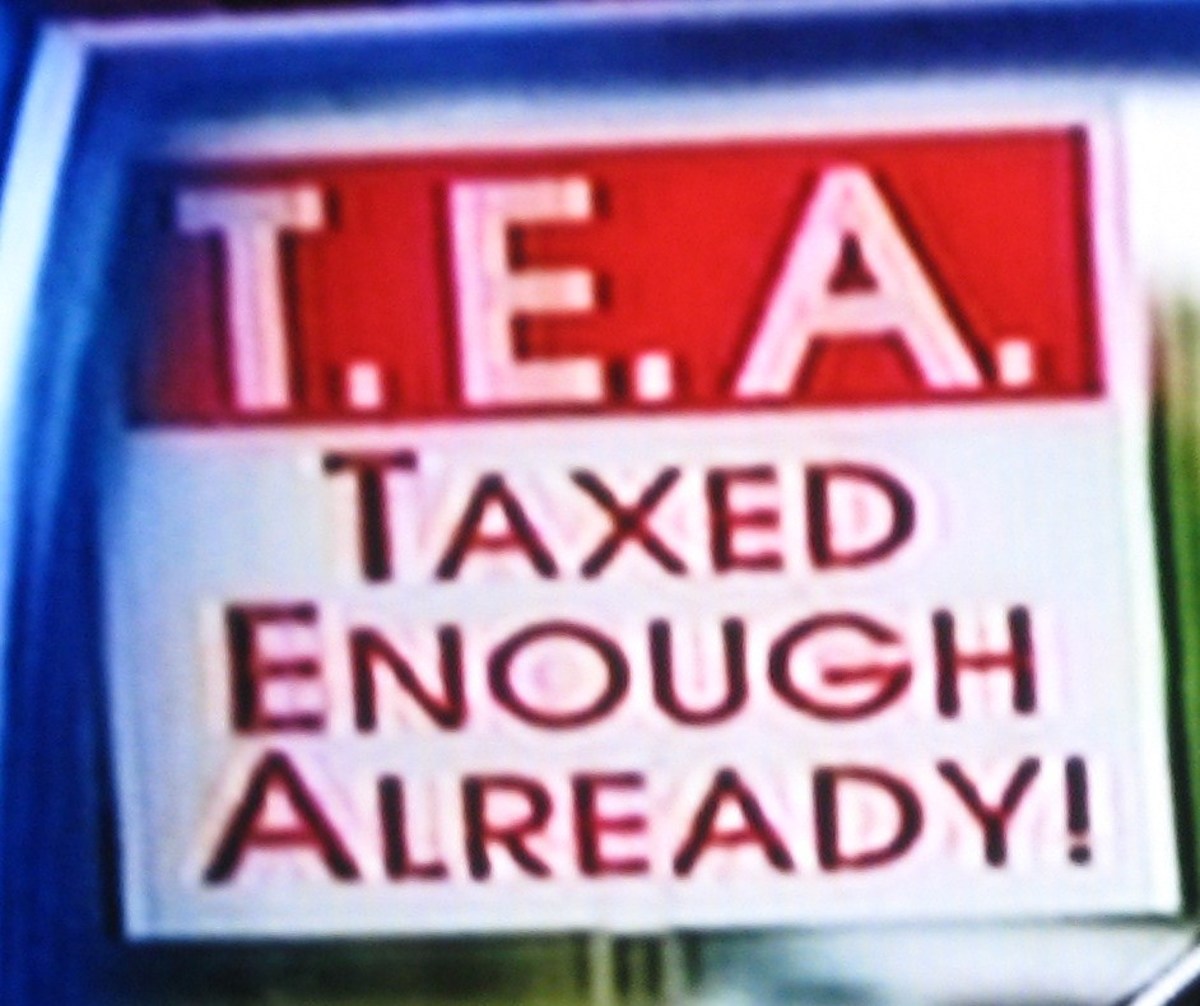
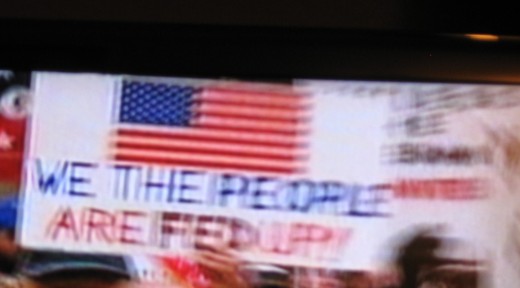
Taxes From King George III to The Present
The protests by the our forefathers forced King George III to back off and rescind most of the taxes.
However, like many liberal politicians in Washington today, King George and his allies in Parliament were fighting to retain the principal that the government in distant London had the right to tax and micromanage the lives of the people in the colonies without any external restraints.
This idea of unchecked power in distant London was alien to the colonists who, from the beginning, while being loyal subjects, had from the beginning enjoyed a large degree of local autonomy. This power grab by the government in London threatened to take away the local autonomy and freedom that the colonists cherished.
Instead of respecting the colonists as loyal subjects willing to do their share for the national good while retaining their freedom to live their lives as they saw fit, the King responded by eliminating all but the small tax on tea but retaining the principle of London's unchecked power.
Today the tea party tradition is being revived as a protest against big government and its taxes that have reached magnitudes that make King George III look like a responsible ruler. Having sprung up quickly and spreading like wildfire, the tea parties have taken both conservatives and liberals by surprise and have left pundits on both sides wondering what, if anything, they will lead to.
Liberals, especially the hard left clique that holds the reins of power in the White House and Congress, are hoping that the tea parties are a temporary phenomenon that will quickly disappear. While conservatives are waiting to see if this spontaneous movement will gain traction and produce leaders who will turn it into an effective force that will stop the current administration from continuing on its course leading the nation to socialism.
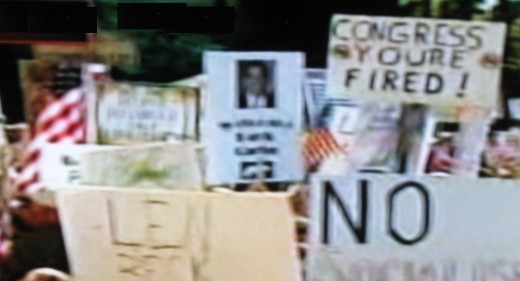
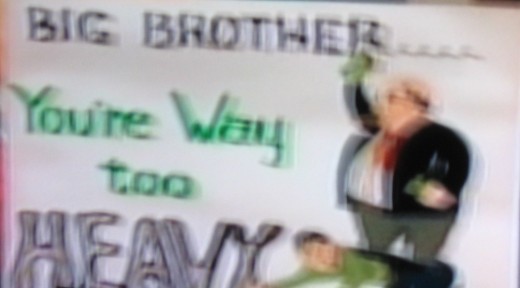

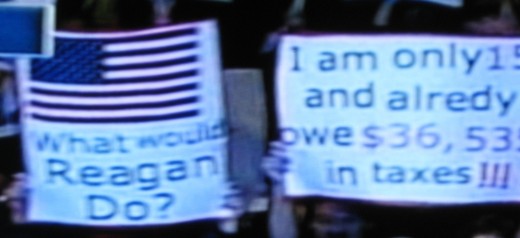
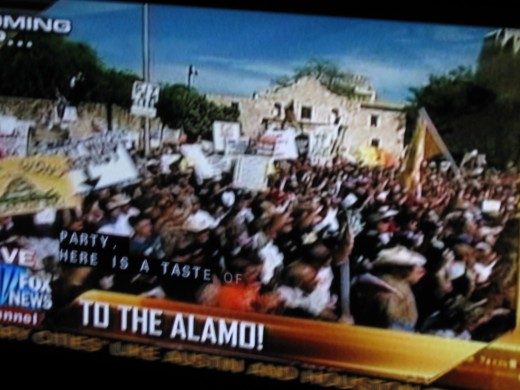
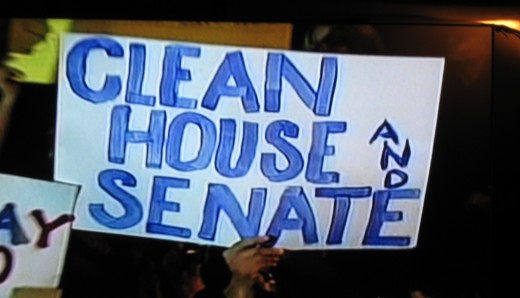
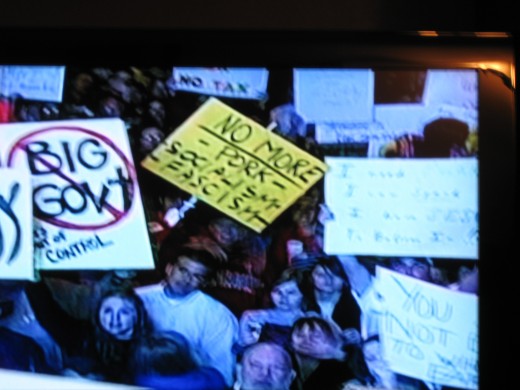
President Obama is Responsible in More Ways Than One
At the moment no one is making any predictions about this grass roots movement which, thanks to the communication capabilities of the Internet, has sprung up spontaneously in cities and towns all over the nation. The organizers are ordinary citizens as are those attending these events. Not only are the participants in these tea parties ordinary citizens, but they are coming from all parts of the political spectrum. Contrary to the claims of many in government and what is left of the mainstream media, these people are not all drawn from what is commonly believed to be the conservative side of the political spectrum.
Ironically, President Obama himself may be partially responsible for the tea parties in more ways than one. Obviously, the immediate impetus behind the tea parties has been President Obama's policies involving massive spending and the need for higher taxes in the future to pay for this spending.
However, during his campaign for President, Mr. Obama not only made use of some of the same Internet tools to reach out to people and get his message to them as well as bring them out to rallies for him, he also deliberately targeted new voters in an attempt to recruit support from those who had never voted previously. He also made CHANGE the central point of his campaign, and kept repeating the theme that he would CHANGE the way government was run in Washington when he was elected. Finally, he promised to first keep the Bush tax cuts in place until they expired and cut taxes for the middle class (low income people don't pay income taxes).
Given the irresponsible spending of the previous Republican Congressional majority and the failure of the Bush Administration to rein in Federal spending, coupled with the massive growth in the Federal government under the Bush Administration, the Republican party had little credibility when it needed to have people take it seriously as the party of fiscal restraint and small government during the 2008 election.
This left the war in Iraq as the main point of difference between the two major candidates and, even here there was not much difference between the two candidates other than the fact that the Republican President Bush had led us into that war which made then Senator Obama the logical choice for those who had come to oppose that war. For a number of Republican, independent and swing voters, candidate Obama was a fresh face who could be expected to basically maintain the status quo and thus presented either a good alternative to the Republican candidate or a way to express their dissatisfaction with the Republicans by voting for candidate Obama (people casting votes for Obama in this manner were voting against McCain rather than for Obama).
President Obama's Campaign Promises Laid Groundwork for Tea Parties
In promising CHANGE, candidate Obama did just that - he promised CHANGE but was careful to never define what he meant by change and this allowed people to come up with their own ideas of what he meant by CHANGE.
This vagueness alone would have caused President Obama some PR problems upon winning, as any changes he made would have angered some of his supporters whose ideas of what to change differed from his. But the real problem as far as the tea parties go is that one issue that emerged during the campaign was the problem of earmarks which, despite the fact that they constitute only 1% of the Federal budget, the $20,000,000,000 ($20 BILLION) ( see Question of Timing on Bush’s Push on Earmarks, by DAVID D. KIRKPATRICK, New York Times, Jan 29, 2008) spent on them each year is still a large amount of money in the eyes of average taxpaying citizens.
Within a month of becoming President, Mr. Obama, not only did nothing about earmarks but approved a record breaking appropriations bill which was labeled an economic stimulus bill but came loaded with earmarks. Adding insult to injury, President Obama even went so far as to acknowledge and justify the earmarks in it. This, along with his proposed budget and inventory of other huge spending programs that even President Obama admits he can't find the money to fund immediately, has obviously been a major spark in igniting the prairie fire of tea parties that is sweeping the nation.
Role of Non-Voters in Restraining Winning Candidates
In addition to the angering many of his supporters who voted for him, or came out and participated in the political process for the first time because of him, and are now angry and disillusioned, there are also the thousands of those who didn't vote (registered voters who choose not to vote, eligible, but unregistered, voters who saw no need to register and vote and those like youth under 18, non-citizen residents and former felons who have not had their civil rights restored) but still pay taxes and are angry about the huge spending that the President is engaging in.
Voting is an outlet in which people who are dissatisfied with the government can peacefully express their frustration and attempt to change the government by electing those more to their liking. Eligible non-voters (registered or unregistered) are more than likely satisfied with the status quo and don't see any need to vote. The larger the number of these voters the more careful the winner of an election must be as there is always the possibility of losing the next election if he or she angers enough of these eligible non-voters sufficiently to make them come out and vote in the next election.
Finally, there are those who voted for candidates other than President Obama. Their candidate(s) lost and, given this, they would ordinarily have to accept that fact and wait until the next election. However, if sufficient numbers of those who voted for the President along with others who didn't vote are upset enough to take to the streets, the supporters of the losing candidates have the opportunity and incentive to join the fray as well thereby adding more bodies to the movement.
CNBC Commentator Rick Santelli First Proposed Idea of Holding Tea Parties on a February 19th Broadcast
As of this writing (April 19, 2009) the tea parties are still at the spontaneous gathering stage with limited local leadership and no clear direction or organized national leadership. The Obama-Pelosi-Reid crowd in control in Washington along with their supporters in the dying mainstream media are hoping that the tea parties will turn out to be a limited event in which people express a momentary dissatisfaction with the income tax and then move on with their lives.
While the largest outpouring of tea parties to date occurred on April 15th 2009, general credit for the idea currently goes to CNBC financial commentator Rick Santelli who, while giving his regular report from the Chicago Mercantile Exchange for CNBC's morning show Squawk Box on February 19, 2009, expressed outrage (and drew cheers from the floor traders around him) at President Obama's proposal to use tax dollars to help people who lied about their income on their mortgage applications (which is a violation of Federal law as stated on the mortgage application) and took out loans for homes that they knew they could not afford. Toward the end of his rant, he made the statement that he would like to invite people to a tea party, by the shore of Lake Michigan in Chicago, on July 4th where people could show their outrage at the government's policies.
The clip of the CNBC segment of Santelli's rant became an instant hit on YouTube and spread quickly around the Internet. Within days, tea parties were being organized and held (this was not just an April 15th event as many were held before that date and Santalli's call for a July 4th party is still open) as well as appeals made to mail tea bags to Senators and Congressmen as a form of protest.
Ideas Propelling the Tea Party Movement
What is clear at the moment about the tea parties is that those participating are:
First, and foremost, upset with the way the government is being run in Washington. This, of course, is broad and unfocused frustration.
Second, the vast majority of those participating and supporting the movement are expressing the feeling that the government is too big - again, a very broad position but a little more focused than the first.
Third, and right up there with the first two, is outrage over spending. All participants agree that the level of spending is too high - of course where and what to cut is the big question mark.
Fourth, Taxes and the current tax system are another big issue shared by most attendees and, like size of government and spending, is more specific than the first but again no clear agreement on what to cut or what to replace the system with.
Reading the signs carried at the tea parties one can see other issues such as calls to abolish the Federal Reserve, respect for Second Amendment rights to bear arms, Texas Governor Rick Perry's call for succession if the Administration continues on its current track and various anti-government grievances.
In addition to the American Flag one also sees the famous Revolutionary War banner with its coiled rattlesnake and words Don't Tread on Me. Portraits of Ayn Rand, the famous libertarian author (Atlas Shrugged and The Fountainhead) who experienced the horrors of big government at the hands of Vladimir Lenin and his Bolsheviks in her homeland in Russia.
Pictures of Tea Parties Taken While Watching Reports on Fox News
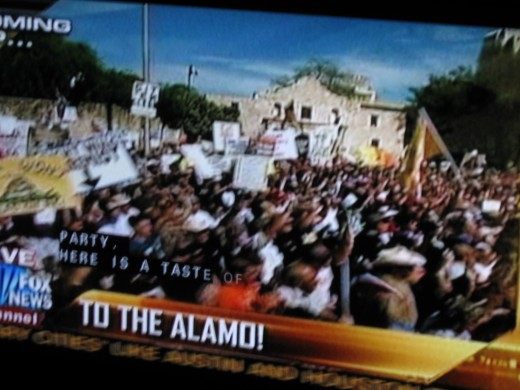
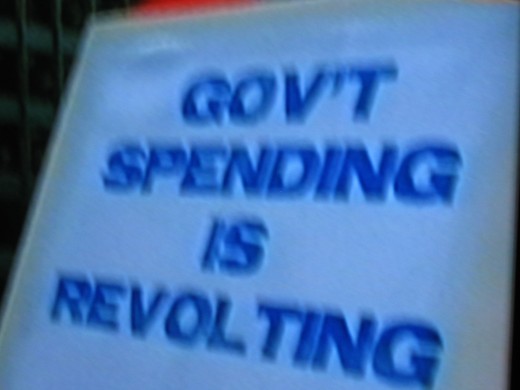
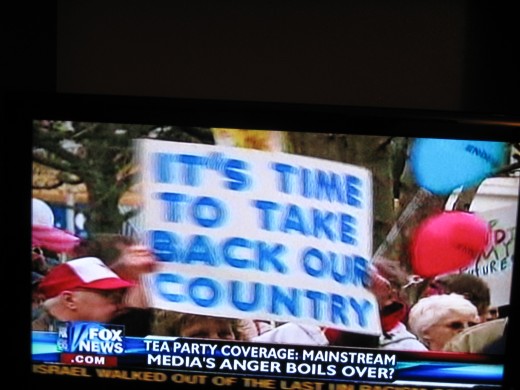
President Obama Could Change Direction and Emerge as Leader of Tea Party Movement
Mass movements also need leadership to sustain and guide the fight. At the moment, leadership is small and limited to local areas. One or more recognized national leaders may be needed to keep the movement going and help it to institute real change. While such leadership could emerge from the ranks, there are some established political leaders who may be willing to gamble their political careers and come forward.
First and foremost among possible leaders could be the President himself. While his approval rating continues to fall among the nation as a whole and the feelings of some of the participants in the tea parties toward him border on hate, most of the reports of the April 15th tea parties indicated that much of the anger and frustration of the the attendees was directed toward the President's policies and not him personally. Also, many of the participants admitted that they not only voted for him but still supported him personally.
While highly unlikely, President Obama could do a 180 degree turn politically and try to assume the leadership of this movement. Many elected Democratic Congressmen and Senators are already worried about the 2010 mid-term elections and concerned about the backlash they have encountered from constituents due to the excesses of the current Democratic leadership in Congress. The President could make such a move and not lose the support of a large portion of his party.
At this point the President could still reposition himself by simply firing the hardliners in his administration and shifting the blame for the unpopular policy moves to House Speaker Nancy Pelosi and Senate Majority Leader Harry Reid both of whom already have a reputation as hard core leftists. After all, the President did campaign on a platform that included tax cuts and change and now that he sees the change that people want, he could make such a move and still retain his credibility.
On the Republican side, South Carolina Governor Mark Sanford has gained some fame and credibility with his refusal to accept the government's stimulus money and the chains that go with it.
Louisiana Governor Bobby Jindal is another Republican governor who has been making a name for himself as an opponent of big government and reckless spending.
Then there is Texas Governor Rick Perry, a Republican with strong small government and low tax convictions and who caused a bit of a stir following his speech at the tea party in Austin, Texas on April 15th when, in answer to a reporter's question, he suggested that Texans at some point might get so fed up with the actions of the Federal Government that they would want to succeed. He quickly added that we have a great nation and he didn't foresee any reason to dissolve it but stipulated that Texans were very independent and didn't like the government infringing on their freedoms. While not calling for succession, this saber rattling by the governor went down well with the crowds.
Finally, there is Governor Sarah Palin of Alaska. There is no question about her popularity with common people and with the conservative base of the Republican Party. Without her, President Obama's election margin of victory probably would have been even greater. I am sure that there are other Republicans who, like me, see in Sarah Palin another Lady Margaret Thatcher and who voted for her despite the running mate she was paired with.
Anyone doubting her potential should read the article by former Special Advisor to Prime Minister Margaret Thatcher, John O'Sullivan, entitled Conservative Snobs Are Wrong About Palin - I know Maggie Thatcher. The two women have a lot in common in the Wall Street Journal's December 23, 2008 online Opinion Journal. In it O'Sullivan describes Lady Thatcher's rough edges and missteps, similar to those of Governor Palin in the last election, early in her career and then shows how she grew politically and used her new found skills to lead the UK from near third world economic status back to the top ranks of economically advanced nations. Like Governor Palin, Lady Thatcher had a strong backbone and firm convictions which helped her to stay on course and pursue her goal of freedom.
Photos From Mid-March 2009 Tea Party in Mesa, AZ
The photos below were taken at a mid-March 2009 Tea Party in Mesa, Arizona. They were apparently sent around the Internet as an email attachment - my sister in New York forwarded a copy of the email and pictures to me - I have cut out and published the sign portion of some of the photos here. Based upon the signs in the photos the main focus of this particular Tea Party was to mock the stimulus bill.
These Signs Say It All
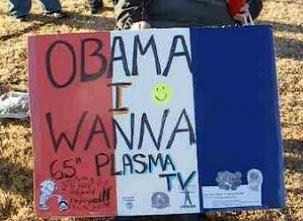
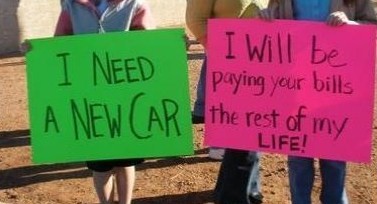
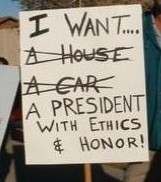
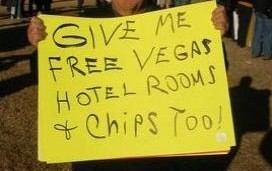
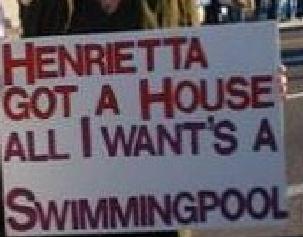

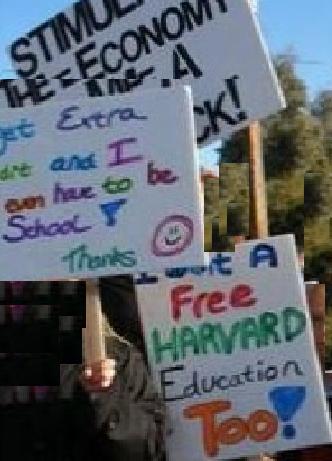

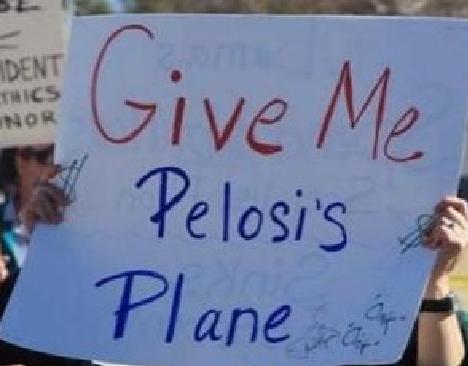
Possible Impact of Tea Party Movement
The first result of the Tea Party Movement could be a major defeat at the polls for Democratic members of Congress in the 2010 mid-term elections thereby thwarting the President's program and sending him to join the ranks of one term has-beens.
Another could be action at the state level to call for a Constitutional Convention to ratify one or more amendments (separate conventions would probably be needed for each amendment) placing limits on federal spending power, or taxing power, or other federal activities that citizens find abusive and distasteful. Such a convention could also be used to put forward an amendment to repeal the Sixteenth Amendment which allows the Federal Government to levy a tax on incomes. While the convention method has never been used successfully to amend the Constitution, the threat, by grass roots movements, to use it has forced Congress on more than one occasion to make desired reforms.
Among changes brought about by this threat of amending the Constitution via the Convention route was the Twenty-First Amendment which was passed in response to threats by the people to call a Constitutional Convention to repeal the infamous Eighteenth Amendment that gave the Federal Government the power to ban the manufacture, distribution and consumption of alcohol. Precedent has thus been set to not only repeal a misguided early 20th Century Progressive Era Constitutional Amendment (the Eighteenth Amendment was pushed through less than a decade after the Income Tax amendment and by the same big government Progressive crowd who wanted the government to manage every aspect of people's lives) but to use the threat of a Constitutional Convention to to accomplish this.
The Twenty-Second Amendment, which limits a president to two terms in office is another one that Congress quickly put forward under threat by the people to push for a Constitutional Convention. This amendment was quickly passed a mere two years after the death of Franklin Roosevelt in 1945 ended his unprecedented 13 year rule as President and can be seen as another example of the distaste of Americans for big government.
The most recent attempt to amend the Constitution by Convention came less than three decades ago in 1983 when citizens of 32 states had their legislatures to pass resolutions calling for Congress to convene a Convention to pass an amendment limiting government spending. Before two more state legislatures passed such resolutions (thereby bringing the total to 34 or the required 2/3 of the states as per Article V of the Constitution) Congress passed the Gramm-Rudman-Hollings Act which required Congress to balance the Federal Budget by 1991.
Since tea parties are an exercise of the right of the people peaceably to assemble, and to petition the Government for a redress of grievances which are guaranteed by the First Amendment (the full text of which reads: Congress shall make no law respecting an establishment of religion, or prohibiting the free exercise thereof; or abridging the freedom of speech, or of the press; or the right of the people peaceably to assemble, and to petition the Government for a redress of grievances.) of the Bill of Rights, the movement could serve as a good civics lesson for the nation. The Bill of Rights, after all, consists of the first ten amendments to the Constitution and was added to the Constitution as the result of a grass roots movement by citizens concerned about protecting American citizens from their government before that government was even established.
Charles Pinckney, a delegate to the 1787 Constitutional Convention proposed a bill of rights for the Constitution during the convention but the members of the convention saw no need and did not include such a listing in the original Constitution.
Once the completed Constitution was presented to the states for ratification, opponents, concerned about preserving and protecting the rights of citizens, began writing and publishing articles urging that the proposed Constitution be rejected (the nation did have a very weak government and weak constitution known as the Articles of Confederation in place at that time).
In response to this opposition Alexander Hamilton, James Madison and John Jay undertook to write and publish a series of articles in support o the proposed Constitution. These articles, originally written anonymously, later appeared in book form under the title of The Federalist Papers .
Those writing in opposition to the proposed Constitution became known as the Anti-Federalists. While I have seen references to the Anti-Federalists, it wasn't until the creation of the Web that the writings of the Anti-Federalists became widely and easily available. Despite the fact that the Anti-Federalists lost and the Constitution was approved, their writings did rouse public sentiment to the extent that the first Congress to meet under our present Constitution was forced to adopt a Bill of Rights which was promptly ratified by the states.
While politicians, media and school civics classes tend to focus on the parts of the First Amendment referring to the separation of church and state, freedom of speech and press, and the Fifth Amendment's reference to the right not to be forced to testify against ones self, the entire document, which is very short, makes for good reading as well. The Ninth (The enumeration in the Constitution, of certain rights, shall not be construed to deny or disparage others retained by the people.) and especially the Tenth (The powers not delegated to the United States by the Constitution, nor prohibited by it to the States, are reserved to the States respectively, or to the people. NOTE: the words United States as used here refers to the Federal Government in Washington) will be a surprise to many people, which is not unusual given that these two amendments, especially the Tenth, have been deliberately ignored and forgotten by supporters of big government from civics teachers to Presidents for the past century and a half.
Simply forcing the Federal Government to abide by the Tenth Amendment would drastically shrink the Federal Government and result in a major devolution of power from Washington to the states. While state governments and state and local politicians can be as wasteful and power hungry as any in Washington, it is much easier for people to organize at the state level to oust a governor or majority of the legislature than to do the same at the Federal Level.
A second advantage to transferring power from Washington to the states is that people would have an additional voting option and that is to vote with their feet and move from a high tax state to a low tax one - all without having to give up their American citizenship (as I explained in a previous Hub, Americans cannot escape taxes by moving to another country as the U.S. continues to require them to pay taxes - even renouncing one's American citizenship does not necessarily free one from U.S. taxes and Congress has passed laws requiring people to continue to pay income taxes on their foreign income for up to ten years or face arrest and extradition back to the U.S. for the crime of not paying American taxes).
Tea Party Movement is Just Another Step In America's Long Tradition of Opposing Big Government and High Taxes
Only time will tell as to what will be the ultimate result of the tea party movement. However, when viewed within the context of America's history, the tea party movement becomes, not an isolated event, but a part of America's long tradition of being distrustful of government and zealous guardians of their freedom. Viewed from this perspective, a big and overbearing federal government is more of a mid-twentieth century aberration than a part of our tradition of freedom.
CNBC's Rick Santalli's Feb 19 2009 Tea Party Invite
CNN Reporter Doesn't Know Difference Between Reporting and Editorializing
Links to My Other Hubs on Taxes and Big Government
- Rolling Stones Prove Tax Cuts Work
In a previous hub entitled How Tax Cuts Work I attempted to explain how reducing high marginal tax rates encourages people to work and produce more. This leads to a larger income base on which to levy taxes... - Young French Workers Vote With Their Feet
As expected, France's April 22n, 2008d runoff election narrowed the field to the two candidates everyone has been predicting would be the final two to face off for the coveted prize in the May 6, 2008 final... - Political Rent Seeking
Mention the word rent to a layman and it congers up images of the payment for temporary use of an apartment, house, car or other type of property. A renter simply pays for the temporary use of a piece of... - Anarchy Reconsidered
Mention the word anarchy and most people visualize chaos and mayhem. This image of chaos certainly fits society's experience with anarchy in the past century or so. After all, it was an anarchist, Leon... - With Romney Out Ron Paul Advances to Third Place
The Super Tuesday Primary Election (February 5, 2008) resulted in Governor Romney deciding to withdraw from the race for the Republican Party's nomination, leaving Senator McCain, the acknowledged leader of... - The Pros and Cons of the Bush Tax Cuts. Do they really favor the wealthy or is that a myth? What wil
Those who favor the continuation of the Bush tax cuts argue that these cuts are needed to encourage investment which, in turn, will result in a stronger economy and more job creation. As I pointed out in my... - Views of Ron Paul and Libertarians on Education and Other Issues
Peeling has provided an excellent answer to the request What is Ron Paul's view of funding education and how does he view other social programs domestically? But I will try to add some more as well. Ron... - Ron Paul The Overlooked Republican Presidential Candidate
Among the numerous candidates currently running for president the most overlooked candidate is a Republican Congressman from Texas named Ron Paul. Ron Paul is a medical doctor by training and... - Democrat vs Republican Tax Cuts
In a previous Hub (see "How Tax Cuts Work") I discussed how a supply side tax cut works. For the past quarter of a century tax cuts have been synonymous with supply side economic theory and Republican... - How Tax Cuts Work
According to October 11, 2006 news reports, the Federal deficit (the amount by which government spending exceeds tax and other government revenues) has shrunk to its lowest amount in four years. In addition... - Krugman on Friedman - A Critique
With the passing of the late John Kenneth Galbraith (1908 - 2006) the job of popularizer of the economics of government economic control of the economy has been taken up by Paul Krugman. Like Galbraith,...











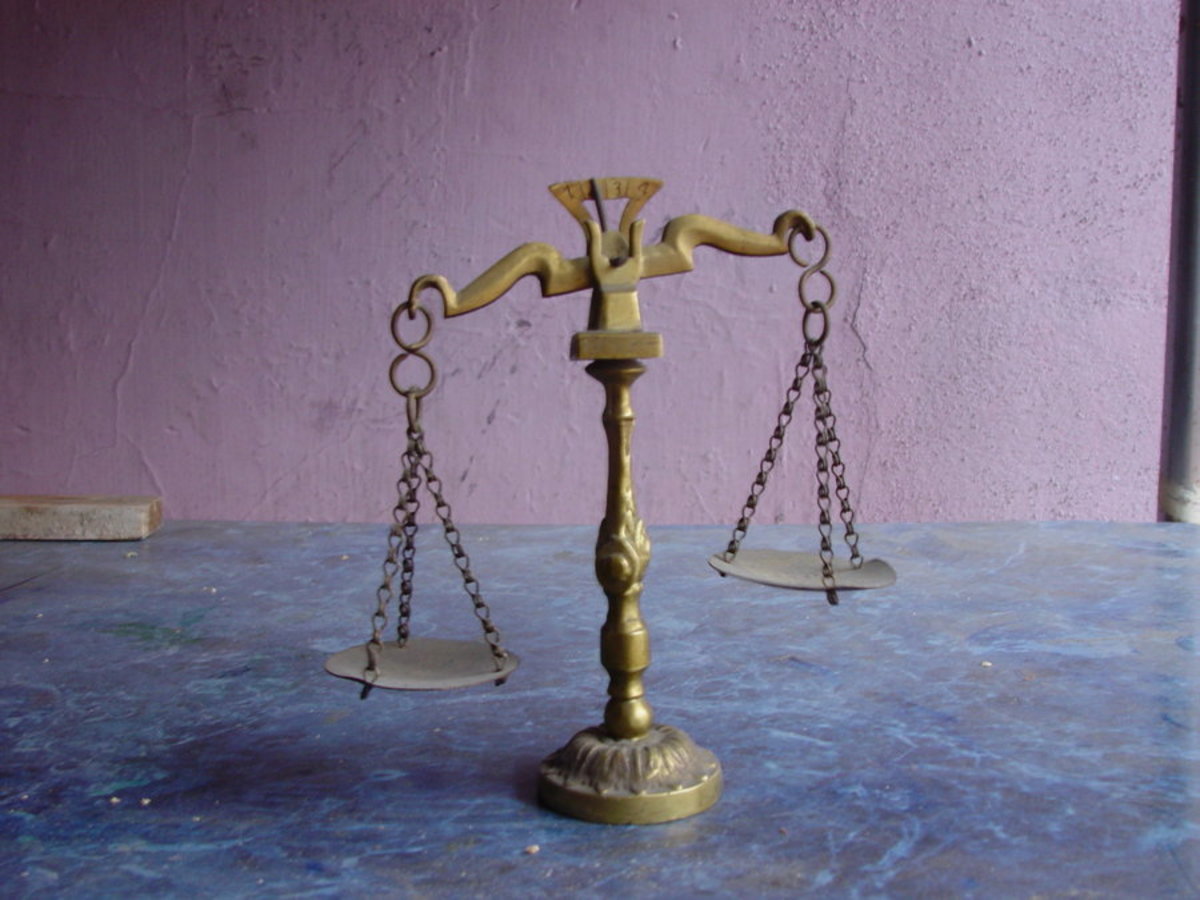
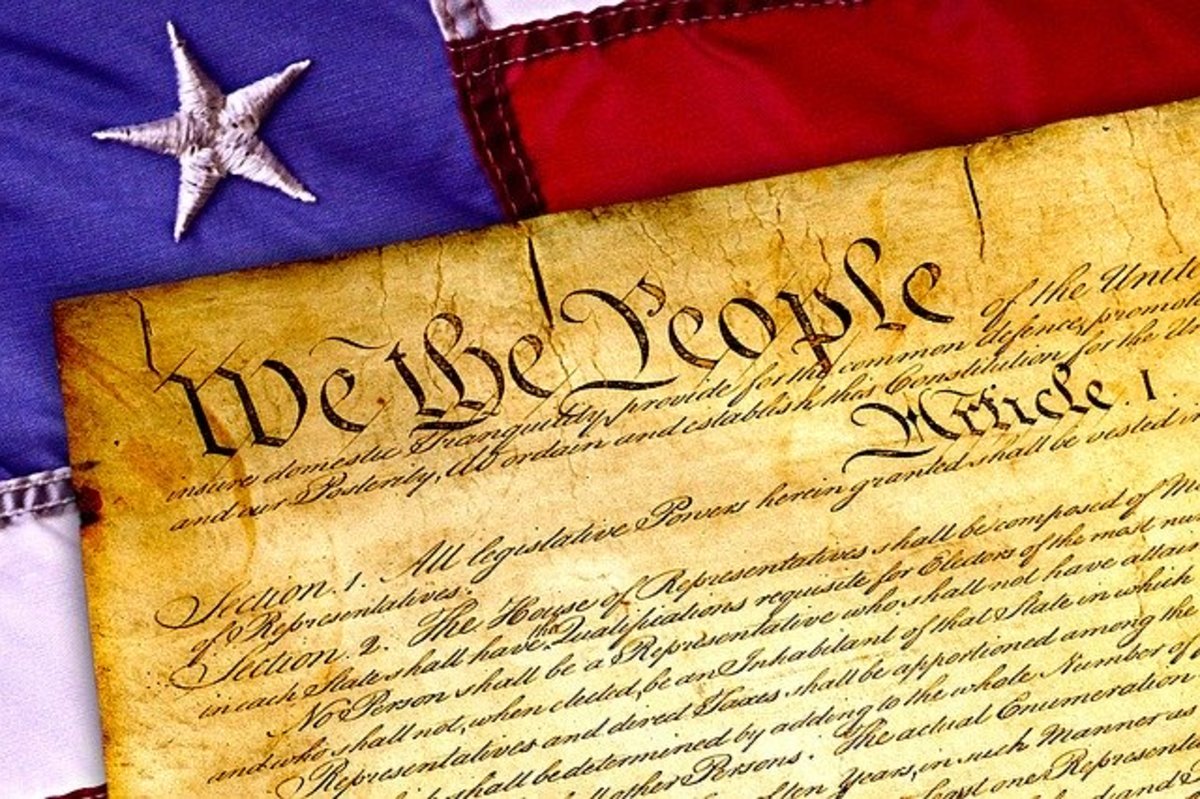
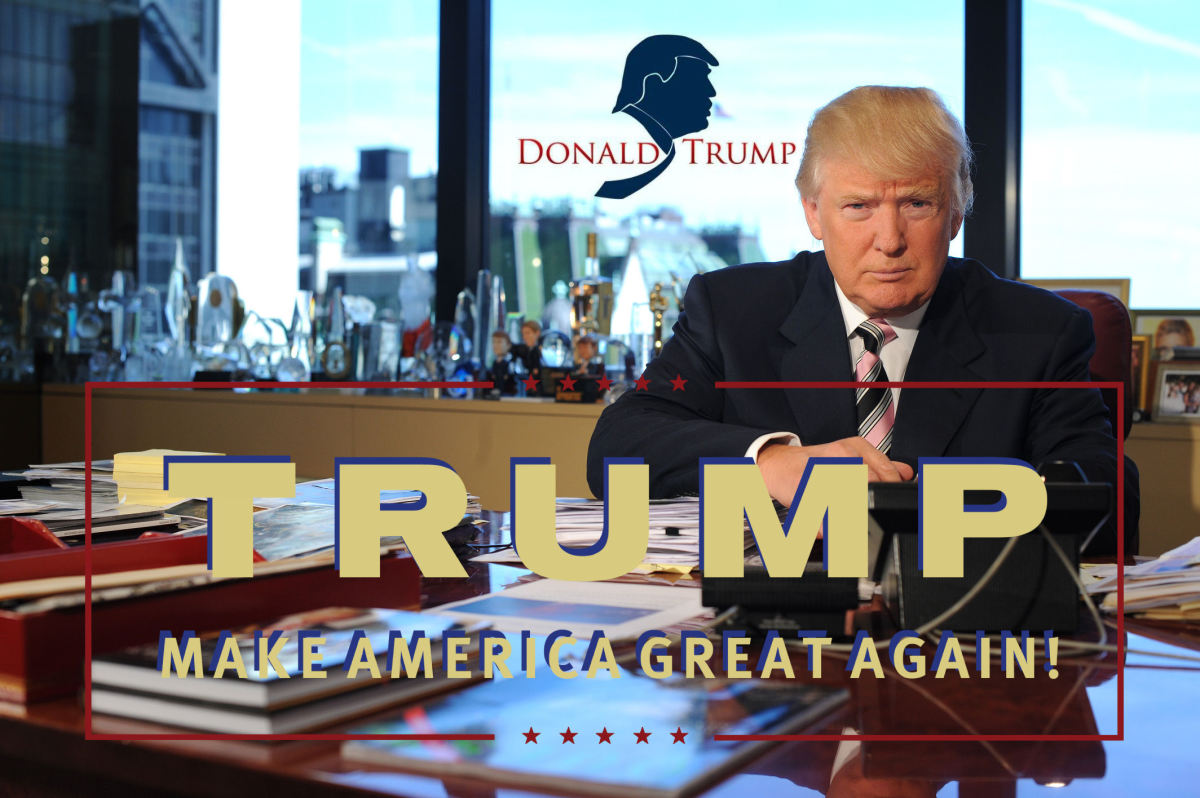

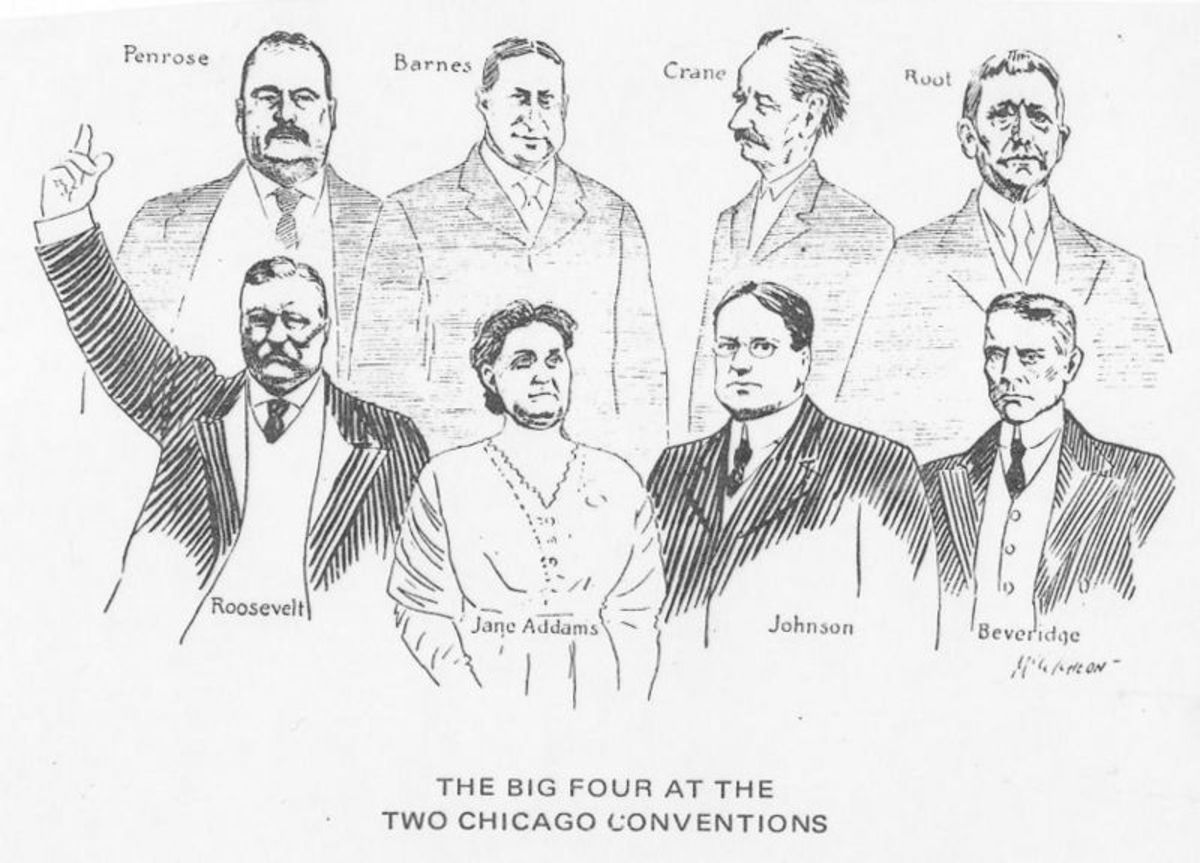
![Obama's General Motors [GM] Tarp Bailout - The Untold Details Obama's General Motors [GM] Tarp Bailout - The Untold Details](https://images.saymedia-content.com/.image/t_share/MTc0MTU0NDA1OTcxNzY1MTE2/obama-general-motors-gm-tarp-bailout-untold-details.jpg)
